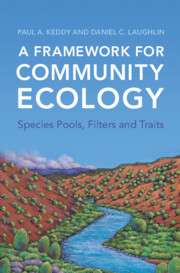Book contents
- A Framework for Community Ecology
- A Framework for Community Ecology
- Copyright page
- Contents
- Preface
- 1 A General Framework for Community Ecology
- 2 Filters
- 3 Species Pools
- 4 Traits
- 5 Trait–Environment Interactions
- 6 Functional Groups
- 7 Predictive Models of Community Assembly
- 8 Prospects and Possibilities
- References
- Index
7 - Predictive Models of Community Assembly
Published online by Cambridge University Press: 18 November 2021
- A Framework for Community Ecology
- A Framework for Community Ecology
- Copyright page
- Contents
- Preface
- 1 A General Framework for Community Ecology
- 2 Filters
- 3 Species Pools
- 4 Traits
- 5 Trait–Environment Interactions
- 6 Functional Groups
- 7 Predictive Models of Community Assembly
- 8 Prospects and Possibilities
- References
- Index
Summary
The CATS model (Community Assembly by Trait Selection) uses average trait values of both species and communities in a system of linear equations to predict the relative abundance of each species in a community C from the regional species pool P. This model has been tested in a variety of habitats. There is an asymptote to the number of useful traits. The asymptote is determined by the strength of covariation among the traits of the species pool. The Traitspace model uses Bayes’ theorem to combine trait–environment relationships and multidimensional trait distributions for each species to predict the relative abundance of each species in a community C from the regional species pool P. Both models can be used to determine the importance of traits in community assembly. Each model has costs and benefits, which future work will clarify.
Keywords
- Type
- Chapter
- Information
- A Framework for Community EcologySpecies Pools, Filters and Traits, pp. 232 - 264Publisher: Cambridge University PressPrint publication year: 2021
- 1
- Cited by

